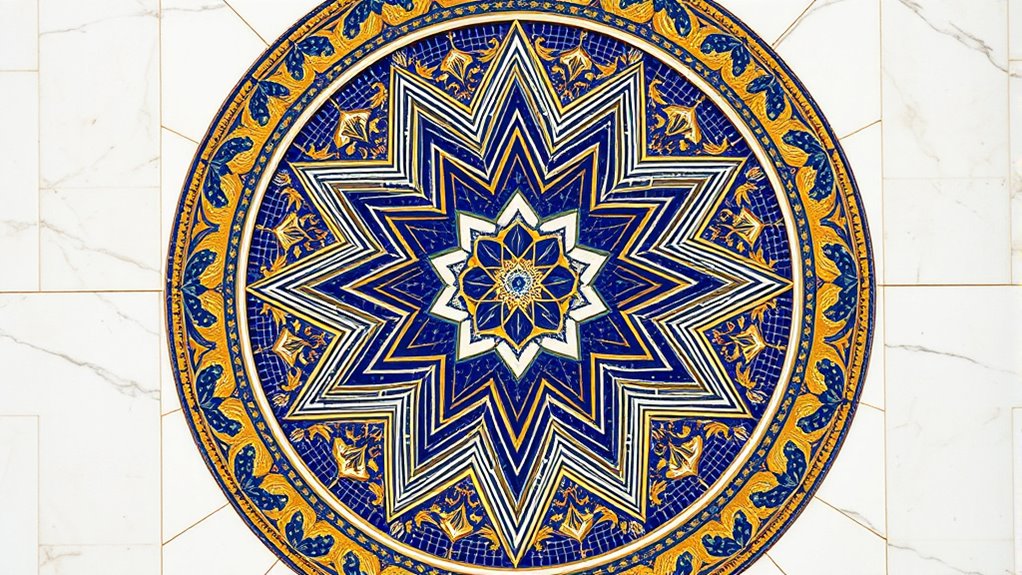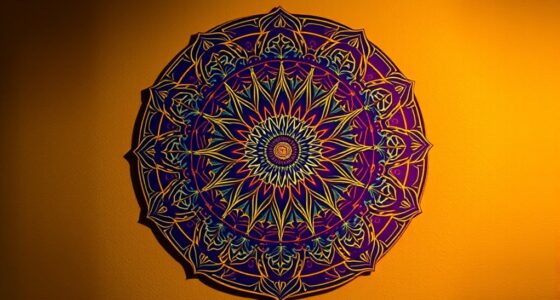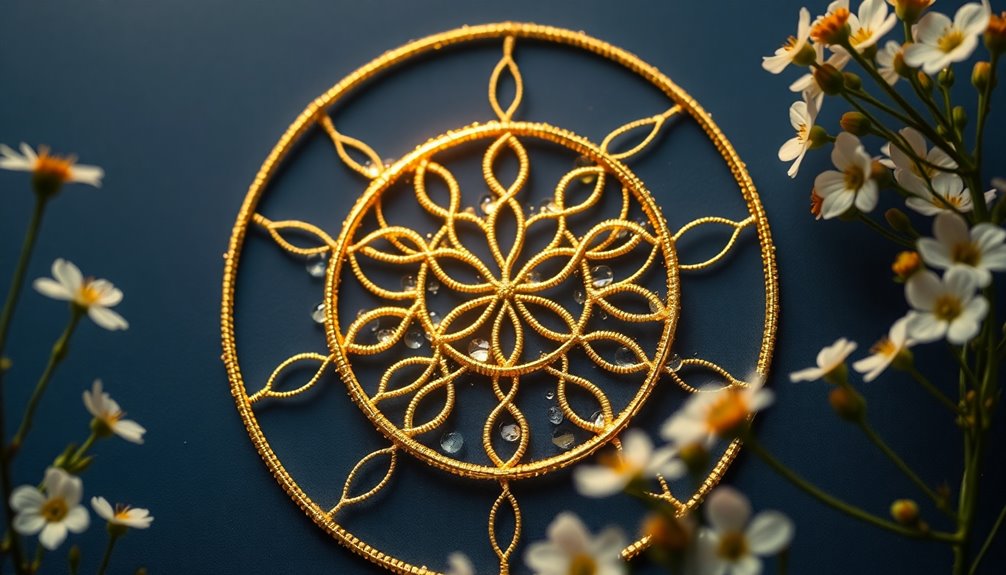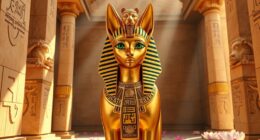Sacred geometry plays a essential role in Islamic architecture and art, using mathematical patterns like stars and tessellations to symbolize divine infinity and harmony. You’ll notice how these designs incorporate symmetry and proportion to represent spiritual perfection, encouraging reflection on the universe’s divine order. These geometric patterns not only create stunning visuals but also serve as spiritual symbols that connect the earthly with the divine. Exploring further reveals the profound spiritual meaning behind these intricate designs and their cultural significance.
Key Takeaways
- Sacred geometry utilizes mathematical patterns like stars and tessellations to create visually harmonious Islamic art and architecture.
- Geometric patterns symbolize divine infinity, order, and spiritual unity, embodying deeper theological meanings.
- Architectural features such as domes and arches are designed with precise geometric principles to inspire spiritual reflection.
- Repeating motifs and symmetry in Islamic art promote meditation on divine wisdom and interconnectedness.
- Sacred geometry integrates spiritual symbolism with artistic expression, reflecting the divine order and harmony of the universe.

Have you ever wondered what makes Islamic architecture and art so distinct and mesmerizing? One key element lies in the use of sacred geometry, where mathematical patterns serve as the foundation for intricate designs that captivate the eye. These patterns are more than just decoration; they embody a deep spiritual symbolism that connects the earthly with the divine. When you gaze at a mosque’s tilework or a palace’s ceiling, you’re witnessing a visual language rooted in precise mathematical principles that evoke harmony, unity, and infinity.
Mathematical patterns in Islamic art often consist of repeating geometric shapes, such as stars, polygons, and tessellations. These patterns are meticulously crafted, reflecting a profound understanding of symmetry, proportion, and repetition. You might notice how a complex star pattern seamlessly interlocks with surrounding motifs, creating a sense of endless continuity. This repetition isn’t accidental—it symbolizes the infinite nature of Allah, reminding you of the divine’s boundless qualities. The precision involved in creating these patterns highlights a reverence for order and balance, key themes in Islamic spiritual thought.
Repeating geometric shapes symbolize infinity and divine boundlessness in Islamic art.
Spiritual symbolism is woven into these geometric designs, elevating them beyond mere aesthetics. The patterns serve as a visual metaphor for the universe’s divine order. When you observe the intricate designs, you’re meant to contemplate the unity of creation and the interconnectedness of all things. The symmetry and harmony in these patterns mirror the perfection attributed to Allah, encouraging a sense of spiritual reflection. The repetitive nature of these motifs invites you to meditate on the infinite nature of divine wisdom, fostering a connection that’s both intellectual and spiritual.
In Islamic architecture, sacred geometry also plays a role in the structure itself. Domes, arches, and courtyards are carefully designed using geometric principles to create spaces that inspire awe and contemplation. The precise measurements and balance in these structures reflect an understanding that space itself can be a vessel for spiritual experience. As you walk through a mosque adorned with these patterns, you’re participating in a sacred act—entering a space designed to elevate your consciousness and bring you closer to divine truths.
Ultimately, sacred geometry in Islamic art and architecture isn’t just about visual beauty. It’s a language of spiritual symbolism encoded in mathematical patterns, guiding you toward a deeper understanding of the divine order that underpins all existence. It invites you to see beyond the surface, to appreciate the harmony and infinite complexity that reflect the divine essence itself. Recognizing the role of mathematical principles in these designs enhances your appreciation of their spiritual significance and demonstrates how deeply intertwined art and faith are in Islamic culture.
Frequently Asked Questions
How Does Sacred Geometry Influence Islamic Architectural Acoustics?
You notice that sacred geometry influences Islamic architectural acoustics by enhancing acoustic resonance and creating spatial harmony. The geometric patterns and symmetrical designs help distribute sound evenly throughout spaces, reducing echoes and dead spots. This precise arrangement guarantees that speech and chants resonate clearly, fostering a spiritual and immersive experience during prayers and gatherings. By aligning geometry with acoustics, you experience a harmonious balance that elevates the spiritual ambiance of the space.
Are Specific Geometric Patterns Associated With Particular Islamic Regions?
You’ll notice that specific geometric patterns vary by region, reflecting regional pattern variations. For example, intricate star motifs are prominent in North African designs, while more complex tessellations appear in Persian architecture. These patterns often carry cultural symbolism in motifs, representing spiritual concepts or local traditions. By recognizing these regional differences, you gain a deeper understanding of how Islamic art expresses diverse cultural identities through sacred geometry.
What Materials Are Traditionally Used to Create Geometric Tile Work?
You typically use ceramic tiles and glazed ceramics to create geometric tile work. These materials are favored for their durability, vibrant colors, and smooth surfaces, which make intricate patterns stand out beautifully. The process involves shaping, glazing, and firing the ceramics to achieve the desired shine and color richness. You’ll find that these materials allow for precise, detailed designs that enhance the aesthetic and spiritual significance of Islamic architecture.
How Do Islamic Geometric Motifs Compare to Those in Other Cultures?
You’ll notice that Islamic geometric motifs emphasize intricate patterns and symmetry, often symbolizing unity and divine order through their complex designs. When comparing these to motifs in other cultures, you’ll find that, while different symbols and styles exist, many share a focus on harmony and spiritual meaning. The comparison of geometric motifs reveals how cultural symbolism shapes artistic expressions, reflecting each society’s values and worldview through detailed, meaningful designs.
Can Sacred Geometry Be Found in Islamic Calligraphy Beyond Architecture?
Have you ever noticed sacred geometry in Islamic calligraphy beyond architecture? You can find calligraphy patterning that incorporates these geometric principles, emphasizing spiritual symbolism. Artists embed intricate, symmetrical designs within the script, turning words into visual meditations. This fusion of form and meaning invites deeper reflection, showing how sacred geometry isn’t limited to structures but also flows through the art of calligraphy, enriching its spiritual and aesthetic significance.
Conclusion
So, next time you marvel at those intricate Islamic mosaics or soaring domes, remember—they’re not just pretty patterns but secret codes of divine wisdom. Sacred geometry isn’t just for the mystics; it’s there to remind you that behind every perfect curve, there’s a universe waiting to be revealed. So go ahead, get lost in the beauty—just don’t forget, you’re also getting a crash course in cosmic secrets, one tile at a time.










